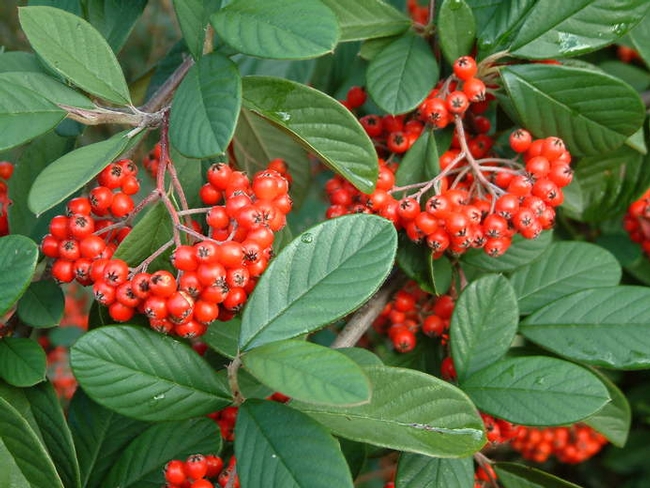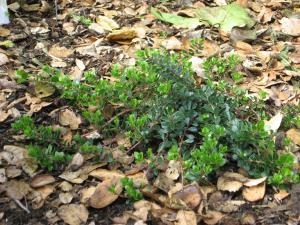Advice for the Home Gardener from the Help Desk of the
UC Master Gardener Program of Contra Costa County
pix: CalPhoto
Response from the UC MGCC Help Desk: Yes, the Cotoneaster lacteus is invasive. For root sprouting species, it is very difficult to find and mechanically remove all roots. Root systems generally spread beyond the width of the leaf area by 3 - 6 inches or more. So if your desirable plants are within 1 foot of the Cotoneaster, their root systems will likely overlap, making complete removal of roots difficult.
The UC Davis guidance mentions 2 herbicides that are effective for chemical control of Cotoneaster and available in California.
Glyphosate concentrate (e.g., Roundup™ for stumps) used as a cut stump treatment is a good option for management of woody weedy invaders. To use, you would leave some of the stems protruding above ground and carefully apply the product to the cut surfaces immediately after making the cuts. A small paint brush is often used for this typr of treatment. Fall is the best time for this type of treatment since the product will be carried down into the roots. If it is not 100% effective the first time, you can re-treat the few sprouts that might come up. Glyphosate degrades quickly, does not spread to other plants in the soil, and has low toxicity to humans and other animals. Glyphosate is usually available in smaller sized containers (eg. 8 ounces). There would not be concerns about replanting if you use this method.
The triclopyr herbicide, sold as Garlon 4 ultra™, has some serious downsides, but is another option. I found a 1 quart size through a Google search of "Garlon 4 ultra" under the "shopping" tab. This herbicide is also best applied as a cut stump treatment and fall is the best time of year to do this. The serious downsides to this chemical are that it can easily spread into water sources via runoff, has a 30 day half-life (i.e. is persistent), and is very toxic to fish and other aquatic species. This product is also volatile and should only be used during cool weather when there is no wind.
If you choose to use chemical control, we recommend that you try the glyphosate concentrate first, and only resort to triclopyr if the glyphosate is not effective after 2 or more applications.
Precautions should always be taken when using pesticides, as detailed here: http://ipm.ucanr.edu/PMG/PESTNOTES/warning.html.

pix: MGSonoma
I hope that this information is helpful. Please do not hesitate to contact us again if you need further assistance.
Note: The Help Desk of the UC Master Gardener Program of Contra Costa County (JL)Note: The UC Master Gardeners Program of Contra Costa's Help Desk is available year-round to answer your gardening questions. Except for a few holidays, we're open every week, Monday through Thursday for walk-ins from 9:00 am to Noon at 75 Santa Barbara Road, 2d Floor, Pleasant Hill, CA 94523. We can also be reached via telephone: (925) 646-6586, email: ccmg@ucanr.edu, or on the web at http://ccmg.ucanr.edu/Ask_Us/ MGCC Blogs can be found at http://ccmg.ucanr.edu/HortCoCo/ You can also subscribe to the Blog (//ucanr.edu/blogs/CCMGBlog/).